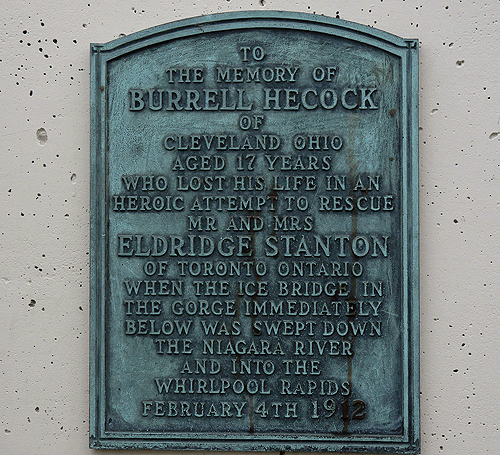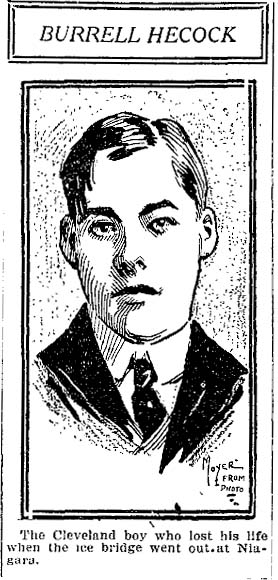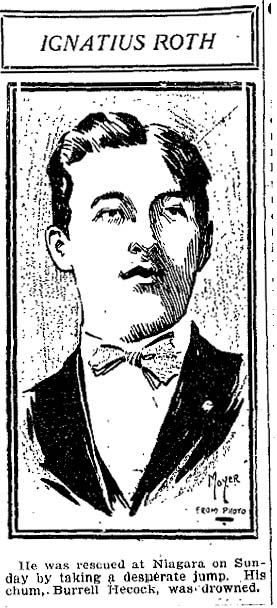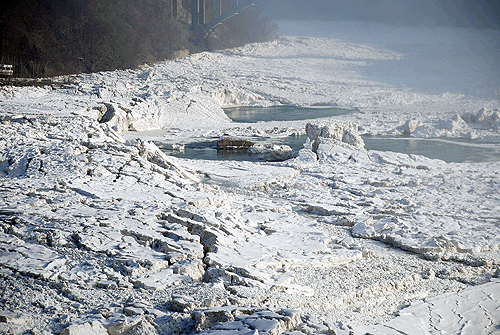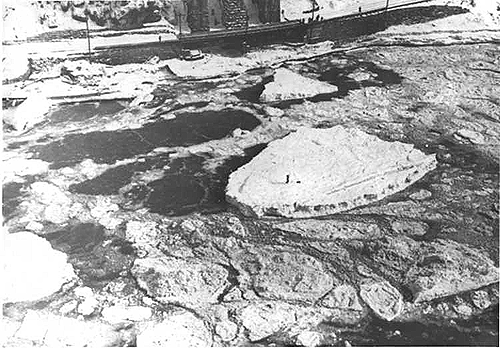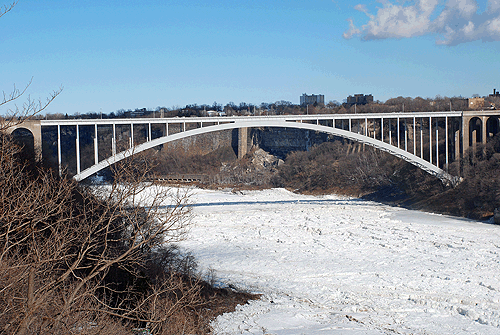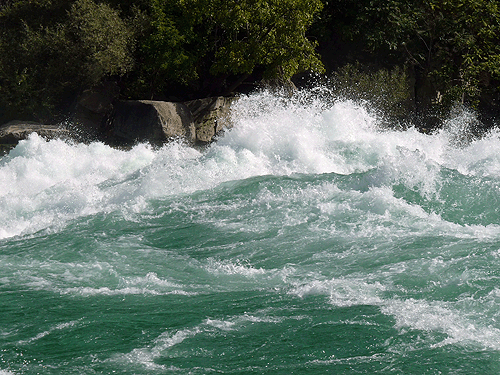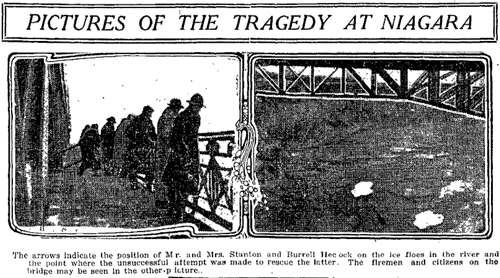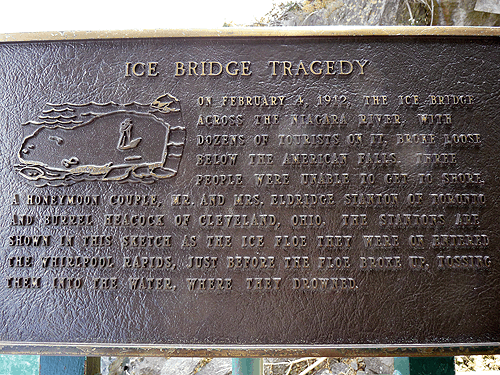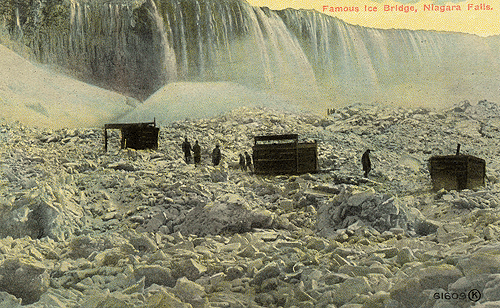|
DEATH ON AN ICE BRIDGE February 4th 1912
TRIO ON ICE BRIDGE CARRIED TO DEATH AT NIAGARA FALLS
Niagara Falls, New York - February 4th 1912
By noon on Sunday February 4th 1912, approximately 35 persons were standing on the ice bridge which had formed covering the Niagara River below the Falls each winter. This ice bridge was huge, thick and solid, allowing people to cross the entire width of the Niagara River from Canada to the USA on the surface of the ice rather than using the International Bridges located downstream. The great ice bridge which has choked the river channel between the cataract and the Upper Steel Arch Bridge below the falls for the last three weeks broke from its shoring at noon today. It shot down the river taking with it to their death a man and woman believed to be Mr. and Mrs. Eldridge Stanton of 247 Huron Street, Toronto, Ontario and Burrell Hecock, 17 years old, of East 117th Street of Cleveland Ohio. Mr. Stanton was 32 years old and a stationer. Mrs. Clara Stanton was 28 years old. The Stanton's had been married for six years and had come to Niagara Falls twice each year; once in summer and once in winter since being married. They had arrived in Niagara Falls on Friday for a winter weekend visit. They strolled hand in hand as they crossed the ice field. Four other persons were on the ice at the time, but managed to get ashore in safety. The bridge was considered safe. For weeks the great fields of ice had been corning down the river, piling up against the barrier, until it was from sixty to eighty feet thick, and under the influence of zero weather the great mass had become firmly anchored to the shore. The jam was about 1000 feet in length and in some places a quarter of a mile in breadth.
Bridge Was Thought Safe
For two weeks it had offered safe passage to the hardy and today an immense crowd of excursionists came to view the winter wonder of the river. Had the accident happened an hour later in the day hundreds would have lost their lives, for the crowd was moving into Prospect Park in the elevators that run down the cliff for the purpose of venturing out upon the ice. Somewhere deep in the great Whirlpool tonight sleeps the man, identified as Mr. Stanton, who twice put aside chances of rescue in order to remain with his terror stricken wife, and who, in the shadow of death—just at the break in the rapids, spurned assistance for himself and attempted to bind about the woman's body a rope dangling from the Lower Steel Arch Bridge. Burrell Hecock was cast in the same mold. Had he not turned back on the ice to give assistance to the Stanton’s, he, too, might have made the shore.
Eight Persons on Floe
On the bridge at the time it tore free from the shore besides Eldridge and Clara Stanton were Ignatius Roth age 17 and Burrell Hecock, age 17, both of Cleveland, Ohio. With him were William "Red" Hill, Monroe Gilbert and William LaBlond and an unidentified Italian, all of Niagara Falls. Hill was opening the little refreshment stand he built every year as soon as the ice was thick enough. Hecock and Roth were throwing snowballs and playing leapfrog. Hill’s shack was nearest to the American shore. Hill suddenly felt a small tremor under his feet. At the same time came a loud groaning sound from the base of the falls which could be heard over the roar of the distant water fall. When Hill heard the grinding and crashing of the ice, he ran at top speed towards the Canadian shore calling to the others to follow him. LaBlond gave them warning that safety lay in that direction. Gilbert and the Italian followed their lead with Hecock and Roth following but the others became confused. By the time they had regained their composure the bridge was moving fast down the river. Mr. and Mrs. Stanton turned back towards the American shore. The ice bridge began heaving up and down as the grinding noises became louder. The ice had begun breaking apart. As the Stanton's ran towards the shore, they suddenly stopped a stones-throw width away as the ice separated from the shore and water appeared where the ice once was. As the gap began to widen, the Stanton's were frozen in place by shock for a second before turning and racing for the Canadian shore. As they started running, Clara Stanton began to slow and stumbled to the ice from exhaustion within 50 feet of the Canadian shoreline. Eldridge Stanton tried unsuccessfully to lift his wife. The ice field on which they were standing began to move. Stanton grabbed his wife and tried dragging her as he shouted for help from the men ahead. When hardly more than fifty yards from the rocky shore Mrs. Stanton on her face, utterly spent. “I can't go on; I can't go on” she cried. “Let us die here”
Texture of an Ice Bridge on
Man and Boy Heroes
And all the time the great field of ice, driven onward by a southwest gale, and pressed by a jam broken free from its anchorage near the base of the Horseshoe Falls, went on breasting the terrible outrush of the Niagara Falls Power company's tunnel outflow, the mightiest current in all the river, without being broken. As Mrs. Stanton fell, her husband strove to get her to her feet again and tried to drag her along the ice, calling for assistance of Roth and Hecock, who were nearest to them. Hecock turned back and returned to the couple and helped support Mrs. Stanton. This act of selflessness cost him his life. Roth struggled along over the hummocks of ice, getting close to an open stretch of water at the Canadian end of the jam. There were men on the shore ready to give him assistance, LaBlond, Hill, William Cook, and Superintendent Harry King of the Ontario Power Company. LaBlond was in waist deep icy water and with the assistance of Hill they pulled Roth to shore and shouted for Hecock to jump to safety. Hecock heard the cries for help from Stanton and turned around. Hecock rushed toward the Stanton's in a desperate attempt to save them. Hecock reached the Stanton's and helped Eldridge lift his wife to her feet. Together they tried to get Clara to shore but the gap between the ice and shore was quickly widening. The three were now stranded as the ice bridge flowed ever quickly downstream. The ice sheet was swinging wildly. On this ice sheet, the Stanton's and Hecock paced back and forth. Hecock and Eldridge were seen talking while Clara stood holding her husband's hand. As they passed beneath the first of three bridges spanning the Niagara Gorge, the ice sheet seemed to edge towards the American shore. Directly downstream, a hydro-electric station was discharging water into the river. The pressure from this discharge crumbled the nearest edge of the ice forcing the three to the opposite side. The giant ice sheet broke into two pieces. One half drifted towards the American shore while the other half on which Hecock and the Stanton's stood remained in mid-stream. The first half grounded out against the American shoreline. On each of the two lower bridges located three hundred yards apart, firemen, policemen and railway workers had stationed themselves in order to lower ropes to those stranded as the passed underneath.
A modern era ice bridge on
Drags Boy Ashore
They were stationed at the bottom of the cliff just at the foot of Eastwood Street. Roth was afraid to trust himself in the icy waters so LaBlond jumped out to the field of ice with a rope and half carried, half dragged Roth ashore. Word that the ice bridge had gone out flashed through the city like wildfire, and within a short time the American shore of the river was lined by thousands of people who witnessed the tragedy being enacted in the deep ravine below them. After getting Roth safely ashore the men made an effort to reach the other three on the ice floe. But at a point about 600 feet below the Upper Steel Arch Bridge the ice field broke into two great fields, one section went towards the American shore and anchored on a great rock near the hydraulic power house. The moving floe with the three helpless beings passed slowly down the river.
Firemen to Rescue The Niagara Avenue firemen were sent to the Lower Steel Arch Bridge, and there took station with a rope. The Canadian firemen had two ropes down from the Cantilever Bridge, which is about 300 yards above the other structure. Just above the old Maid of the Mist landing, a quarter of a mile from the whirlpool rapids, the floe on which the three were borne broke into two sections, each about 200 feet square, Mr. and Mrs. Stanton on one, Hecock on the other. Stanton was seen to place his arm around the waist of his wife. Hecock waved and shouted something. Stanton returned the salute. Clara crouched down beside her husband. The river current was becoming faster as it neared the rapids.
A modern era ice bridge
on
Brave in Face of Death
Burrell Hecock waved his hand to his companions in distress as his floe moved clear of the other, and caught in a current, raced down the river. The other ice floe then shot towards the American shore, and was caught in an eddy and whirled there for about five minutes. This was within sight of the tumbling waters that marked the beginning of the rapids—and death. Hecock saw the ropes dangling from the bridge and made ready to catch one. Very coolly he took off his overcoat and posed himself on the tossing floe. In his course there dangled one rope and a second was moved towards him. He caught the rope that was held by Officer Pat Kelly of the Ontario Police Force and a company of about twenty railway men—Hecock caught it and jumped free of the ice. The sag of the rope at the great drop of 200 feet let him fall into the chilly water up to his waist. And before he was clear of it he was frightfully battered by three successive floes of jutting ice.
Boy Drops Sixty Feet
Not content with the efforts of the men above to draw him up, Hecock tried to assist himself climbing hand over hand. The time was 1 o'clock, and the hour or more that the boy had been on the ice, and the efforts of the icy dunking had sapped his strength. He stopped trying to pull himself up and hung limp on the rope, which spun him around like a top. Kelly and his men pulled steadily, ten feet, twenty, twenty-five, thirty feet—up he came. The great crowd on the bridges cheered—those that were not weeping. Grimly Hecock hung on, trying always to get himself or his leg wound about the rope. Then his hands began to slip. He sought to get hold of the rope with his teeth, but could not. Finally just as he was about sixty feet clear of the water his head fell back. He was utterly spent. He lost his grip and plunged far down into the stream. When Hecock surfaced, his face turned towards the great wave in the rapids ahead. He feebly moved his arms in the breast stroke, but the mighty rush of water was too much for him.
The Niagara River Whirlpool Rapids that claimed the lives
Tossed About Like Cork
Burrell Hecock was caught like a cork and was sent racing on into the midst of the seething waters. For perhaps a half minute he was in view, and then he disappeared in the spume. The Stanton's had watched Hecock's valiant attempts. Hecock’s failure was witnessed by Eldridge Stanton. His wife apparently dared not look. Mr. Stanton appeared calm as he in turn prepared to make a play against death, when, caught by a downriver current, the floes moved into the course that Hecock had gone. As the flow swirled under the cantilever bridge, Stanton quickly grabbed the nearest rope and looped it around his wife's waist. As the flow continued and the rope became taut and broke. Mr. Stanton waved the torn end toward the crowd. Stanton grabbed another rope as they passed underneath the Lower Bridge. He quickly tied the rope again around his wife's waist but changed his mind and untied the rope, knowing it would be futile. Stanton took his wife in his arms, kissed her and let her down. They both knelt together with his arms around her. The flow remained intact until it reached the giant wave in the rapids and spilled over throwing both into the raging water to their deaths. As the couple swung under the cantilever bridge, Mr. Stanton grasped a rope and tried to put it about his wife’s waist. The force of the current was too much for the rope. It broke apart and Mr. Stanton waved the torn end toward the crowd. There was still another chance—the rope that was dropped from the Lower Steel Arch Bridge by the Niagara Avenue firemen. As the floe went into swift drift, Stanton caught it and grimly hung on. He was given slack and he tried to wind the rope about Mrs. Stanton’s waist. He fumbled in his agony of effort as if his hands were numb. The rush of the ice in the stream was overpowering. When he could not tie the rope about his wife, he let it go.
(courtesy Toronto Star)
Thinks Only of Woman
There apparently was no thought of himself. Mr. Stanton raised his wife to her feet, kissed her, and clasped her in his arms. Mrs. Stanton made as if to cross herself and then sank to her knees. Eldridge knelt beside her, his arms clasped close about her. So they went to their death. The ice held intact until it struck the great wave. There it was shivered; there the gallant Mr. and Mrs. Stanton disappeared from view. The direct cause of the breaking of the ice bridge is believed to have been the impact of a free flow of ice from above the falls. The field at the base of Horseshoe Falls disappeared with the bridge, and an eye witnesses declare it broke away first, piling down upon the span of ice across the stream with terrific force and with a din-like the firing of a battery of artillery. The ice bridge that broke away was a week old, and was the third bridge which had formed this winter. It was not of the substantial lake ice that comes later in the season with a thaw, but was of soft, slush ice without substantial body. Thus it was lighter than ice bridges usually are, and for this reason was easily set afloat by the rising river when the wind drove an unusual amount of water down from Lake Erie. That the bridge gave way on a severely cold day was a surprise, for while it might be expected in warm weather, ice bridges have been thought safe in cold weather. An ice bridge went out in the very same manner on January 22, 1899 but 36 persons who are caught on it escaped to the shore.
Commemorative Plaque at the White Water Adventure (whirlpool rapids
boardwalk)
Boy Relates His Experience
Cleveland, Ohio- February 4th 1912 Ignatius Roth, who was rescued at Niagara Falls today when Burrell Hecock, his companion, was drowned, came back to Cleveland tonight to tell his mother how he won his life from the cracking floes of the ice bridge by a happy catch of a rope's end. “Burrell and I had crossed the ice bridge from the American side nearly to the Canadian side," he said "We took some pictures and then started back toward the American side. There were a man and a woman near us. We were about in the middle of bridge when I heard a cracking sound. I laughed, because it didn't seem to be anything serious, and we did not run.”
Shore Seems to Move
“I told Burrell to see if other people had heard anything. Then I heard a rumbling-sound, and the ice bridge was broken. It seemed as if the shore moved and we stood still, as the ice broke down toward the rapids. The four of us, the man and woman, Burrell and I, were all together In the middle of the river. We began to get scared, and we ran first this way and that. There were some shanty men on the bridge and they ran to shore. The shanty men ran towards the Canadian shore, and one of them, Red Hill, I think his name was, yelled to us to come to the Canadian side. They got off, but when we got there the ice had parted. We ran again to the American side. The man and the woman had been running to and fro as the ice broke up. Finally the woman fell down, and the man called to us to help him. He said he could not do anything alone. We went back and tried. Then I ran to the Canadian shore and didn't see the others again.”
Ice Bridge and Shanties
TELLS HECOCK'S BRAVE END
Cleveland Ohio - February 5th 1912
Companion of Niagara Victim Last Heard: "Don't Tell My Mother."
"Don't tell my mother" were the last words shouted by Burrell Hecock across the widening waters of the Niagara River to Ignatius Roth, his companion from this city. Then the rapid current swept Hecock beyond the hearing and sight of Roth, who had leaped to a neighboring ice floe. Roth saw nothing more of his friend, a projecting point hiding the tragic end of Hecock and Mr. and Mrs. Stanton. Young Ignatius Roth, who arrived home late last night, told how he and Hecock crossed to the Canadian side on the ice bridge and took pictures. Returning, the bridge began to rumble. Hecock dropped the camera, but Roth picked it up. Hecock took it from him and smashed it on the ice. “This is no time to think of cameras” Hecock said "We must fight for our lives." As Roth and Hecock ran, Mr. Stanton behind them shouted for aid for his wife. Roth and Hecock stopped and Hecock took the woman by one arm with Mr. Stanton holding the other. Roth made his way toward the Canadian shore. Leaping a break in the ice, he called to Hecock: “Can't you make it'?” “No. Good-bye” replied Hecock “Don't tell my mother.” Roth then caught the rope thrown him and was drawn to safety.
Dog Found Alive in Shack on Niagara Ice Floe
Niagara Falls, New York- February 6th 1912
The large collie dog was yesterday afternoon rescued off an ice floe on which the Stanton's and young Hecock of Cleveland were for a time, after the ill-faded ice bridge moved out Sunday, carrying the three to their deaths. The victims would probably have been rescued had they remained on this floe, which anchored off of the plant of the aluminum company and remained intact throughout from the time the ice bridge moved out. A dozen venturesome employees of the plant ventured out on the ice yesterday in hope of finding the victims of the tragedy. They were surprised when they opened the door of the shack to have the dog, almost famished with hunger and shivering with cold, jumped out and lick their hands. Nelson R. Butcher and Oliver B. Stanton of Toronto were here yesterday afternoon and claim the effects of their daughter and brother respectively. They had a long talk with A. N. Allen, owner of the hotel, and also made arrangements for the recovery of the bodies. Before going on their fatal expedition Mr. and Mrs. Stanton purchased a number of articles, which were sent to Mrs. Stanton's mother in New York. Superintendent Harris of the State Reservation, and Superintendent Jackson of Queen Victoria Park, after a long conference yesterday afternoon, said they would shortly issue orders which hereafter would prevent anyone from venturing on the ice bridge.
Bodies Not Found
A report was in circulation that the bodies had been recovered this morning at an early hour, but upon investigation being made by Ontario police and undertaker Russell the report proved to be without foundation. A sum of money has been left with the authorities here by relatives for patrolling purposes. Fred Preston, of the city, who was well acquainted with every part of the rapids, has volunteered to keep a close watch. He patrolled all yesterday and today, but is of the opinion that the search is fruitless on account of the vast amount of ice.
Were to Visit Fenwick's Mr. and Mrs. Stanton were personal friends of Mr. and Mrs. D. Fenwick, Bridge Street, Niagara Falls, Ontario, and were on their way over here to visit the Fenwick's on Sunday afternoon intending to cross by the ice bridge and returned by the lower steel arch bridge, having notified Mr. and Mrs. Fenwick on Saturday of their intended visit. Mrs. Stanton and her mother visited Mrs. Fenwick about six weeks ago; Mrs. Stanton then expressed her keen desire to cross the ice bridge.
The Tragedy at Niagara
[This is an editorial from the Toronto Star] Toronto, Ontario-February 6th 1912
To have even witnessed the tragedy of Niagara Falls on Sunday must be ranked as a serious misfortune in itself, since those of us who were not present have been so deeply moved by the story of it. Another terrible chapter has been added to the history of Niagara, and the terrible part is that it is not merely the losing of the lives, for as we know lives are lost every day in circumstances bad enough, but the tragic and pathetic feature of this affair was the presence of hundreds of eyewitnesses, who were exhausting all the resources of man against the quiet malevolence of natural forces moving steadily for an hour towards the destruction of three human lives. The ice fields moved down the drain of the gorge as they have done for thousands of years, as unmindful of man as a man had never inhabited the earth. Among the eyewitnesses were men so moved by the tragedy being enacted and before them that they would have sacrificed the fortunes they had almost sold their souls to gain, if by doing so they could have rescued the three unfortunate fellow-creatures they had never seen before, and whom, an hour earlier, they may have passed on the street without a look. Among the onlookers were men who were not only willing to, but did risk their lives in vain efforts at rescue. Men did the most daring things that day, clamoring with ropes down and along the icy walls of the gorge hoping to save life. Nothing reflects more credit on us as a people than the way men of our race can meet death when they must. The story of it comes to us over and over again, winter and summer, from sea and forest, mine and river. When a ship founders or a crowded building burns, men step forward and quit themselves like men. In this case a man and a boy went to death like men. Burrell Hecock, of Cleveland Ohio, was but a boy, yet he turned back to help Mr. Stanton with his wife. He could've escaped, for the companion with whom he was with, reach safety. He may not have known that he was actually choosing between life and death at that second of time, but he did know that the peril of the woman was greater than his own, and he promptly increased his own to reduce hers. It was the decision of a brave mind, and his subsequent conduct was in keeping with the views of him. When the ice broke and separated him from the man and woman, to whose agency had gone-strangers whose names he did not know, and whose wraped-up faces he had never seen, he waved his hand to him encouragingly. "He was an only son" said his friend who survived, "and this will break his mother's heart". But from all over America mothers will send sympathy to one who mourns the loss of such a son. No doubt he was just a normal boy, but in the crisis he rose to greatness. "The bravest man I ever saw" is the tribute paid to Eldridge Stanton by Alfred Scott, who tried to get a rope to him. He faced his fate with equanimity, and devoted all his attentions to his wife. It was her life, not his own, he sought to save, and when a rope dangled from the bridge high above, reach him at one time it was her form he sought to tie to the lifeline. But it could not be done. The last man to exchange words with him says that he was quiet and self possessed. He put his arms about his wife and looked death in the face, unafraid. Modern business life is not heroic, but it often happens that in a time of stress men show that the spirit of the race does not change.
Patrolling River in Hope of Finding Bodies of Victims
Nelson R. Butcher, his son and O. B. Stanton returned from scene of tragedy
Rescue was impossible
February 6th 1912 Many messages of condolence are being received by the bereaved family Nelson R. Butcher, his son, Reginald and O. B. Stanton returned last night from Niagara Falls, where they had passed the day, discharging the melancholy duty of learning further details of the Sunday tragedy, in which Mr. Butcher's daughter, Clara Stanton and her husband Elderidge had lost their lives in the rapids. Though Mr. Butcher and Mr. Stanton had not sent word that they were coming, they were met at the Niagara Station by Mr. Willox, chief immigration officer, Mr. Phemister, G.N.W. agent, and Mr. McNamara, of the Provincial Frontier Police, and given all available information. They saw the route of death taken by Mr. and Mrs. Stanton on their awful journey of one hour and ten minutes.
Rescue Was Impossible
"As we saw the conditions under which the rescuers attempted, we recognize the great difficulties that presented themselves," Mr. Butcher stated this morning. "On either side, the ice formation was such that little or nothing could be done. We have engaged a man to patrol the river for some days until it is thought useless to continue as a matter of fact the presence organization is so thorough and efficient that nothing can be done to improve" Both Mrs. Butcher and Miss Verna Butcher are ill from grief. The mother suffered greatly even when there was a faint hope that Mr. and Mrs. Stanton might be alive. Letters and telegrams of sympathy have come to the bereaved families. Mr. Butcher is well known throughout America, and to some extent, across the Atlantic. Of these messages of condolences, a number are from the Canadian judiciary.
River Man Engaged to Watch for Bodies
Wednesday February 7th 1912 Nelson R. Butcher received word this morning from C.E. Willcox, immigration officer at Niagara Falls stating a noted river man, Preston by name, had been engaged to watch the lower river for three weeks, in the hope that the bodies of Mr. and Mrs. Eldridge Stanton might be found. Mr. Willcox is not sanguine as to the result, but regards his patrol method as the only one that promises any chance of success. Between banks of ice, a torrent of slush and broken ice rushes, the river man considers it barely possible that the bodies may attach themselves to the floating ice or be found floating to one side or the other in the downward flow. "I have heard nothing further" said O.B. Stanton, brother of the late Eldridge Stanton this morning. Letters of condolence continue to pour in. Mr. and Mrs. Butcher in particular have received a large number from judges, lawyers, public men and personal friends and each succeeding mail delivery adds to the number.
Mrs. Hecock Denies Story of the Vision
February 14th 1912 Mother of lad lost in Niagara River contradicts tale from Cleveland. "Not an atom of truth in it" is the way friends of Mrs. Hecock, of Cleveland, mother of Burrell Hecock who was drowned with Mr. and Mrs. Stanton at the breaking of the ice bridge at Niagara a little over a week ago, characterize the story about Mrs. Hecock seeing a vision of her son in a glass of water she was drinking at the time her son was floating down the river. In a letter received this morning by Mr. G. W. Holmes, barrister, of the Janes building, Mrs. Hecock herself says "there is not one word of truth in it, whatever".
Tragedy of Niagara Ice Bridge Recalled
Papers in the estate of Eldridge Stanton filed in Surrogate Court Eldridge Stanton…..$705 Papers in connection with the estate of Mr. Eldridge Stanton, who with his wife Clara and Burrell Hecock, who stayed to assist them and went to their death when the ice broke free in Niagara Falls on Sunday, February 4th, were entered into Surrogate Court this morning. The tragic death of the couple and the vain efforts made to save them will be recalled. Mr. Stanton died intestate and, according to the papers "in a common catastrophe in which his wife also died". His estate totaled $705, including five and half shares of O. B. Stanton and Wilson Company stock worth $450. The remainder was household goods and bank balance. The beneficiaries are Oliver B. Stanton, brother, of 54 Young Street, Toronto ; Mrs. Verna Sheard, of 314 Jarvis Street, Toronto and Mrs. Mabel Lawson, sister of Buffalo, each of whom receive one third of his estate.
May 16th 1912 Mr. Nelson Butcher, father of Mrs. Eldridge Stanton said that he feared the chances of finding the bodies of Mr. and Mrs. Stanton were very small. "A watch is still being kept along the river" he said "and the whirlpool Rapids have been watched by kind friends." Immigration officer McNamara has been particularly kind in this regard but the hopes are now very small, since the ice is gone out, of finding them.
Date last updated: February 10, 2012
THANK YOU FOR VISITING THE
DEATH ON AN ICE BRIDGE February 4th 1912
|
||||||||||
